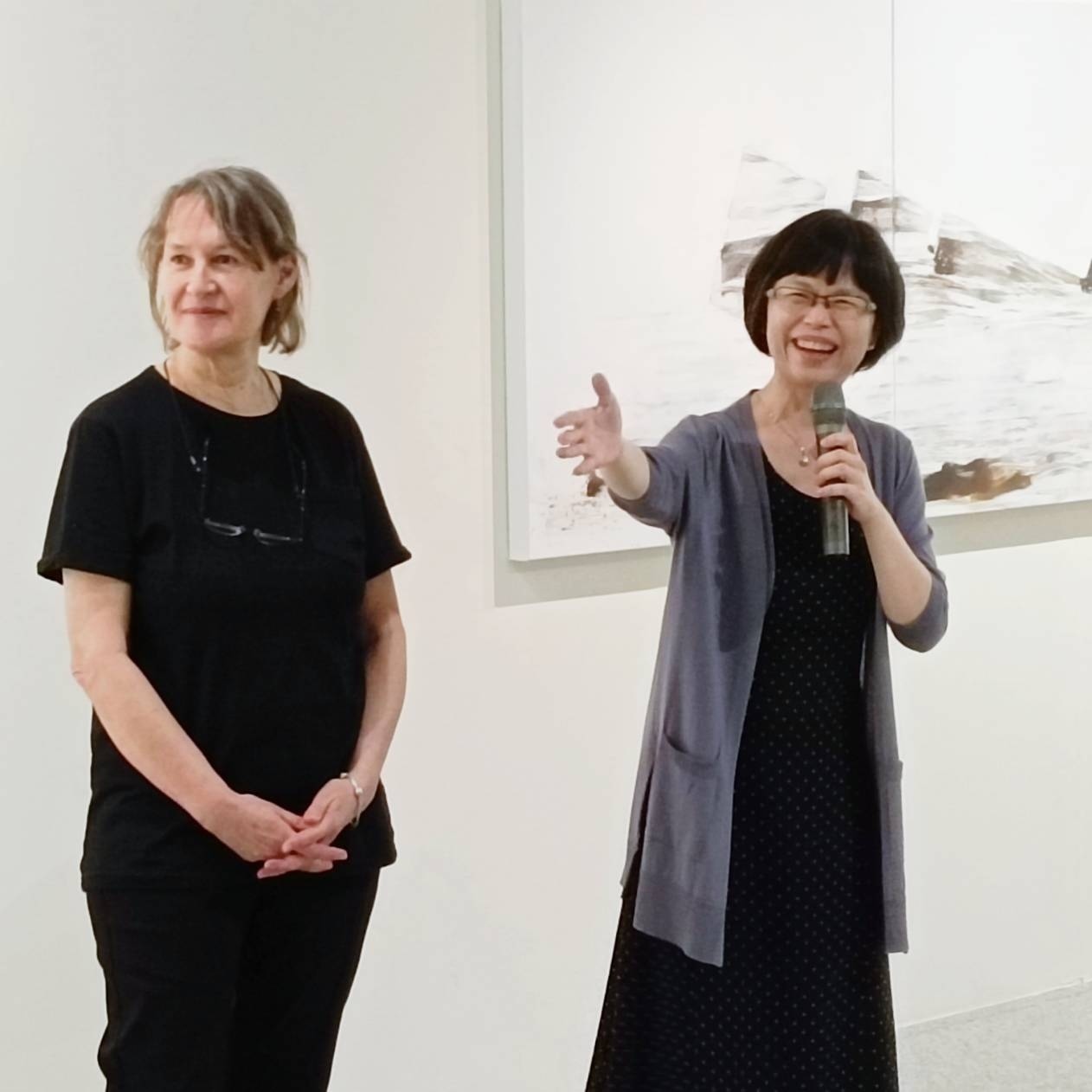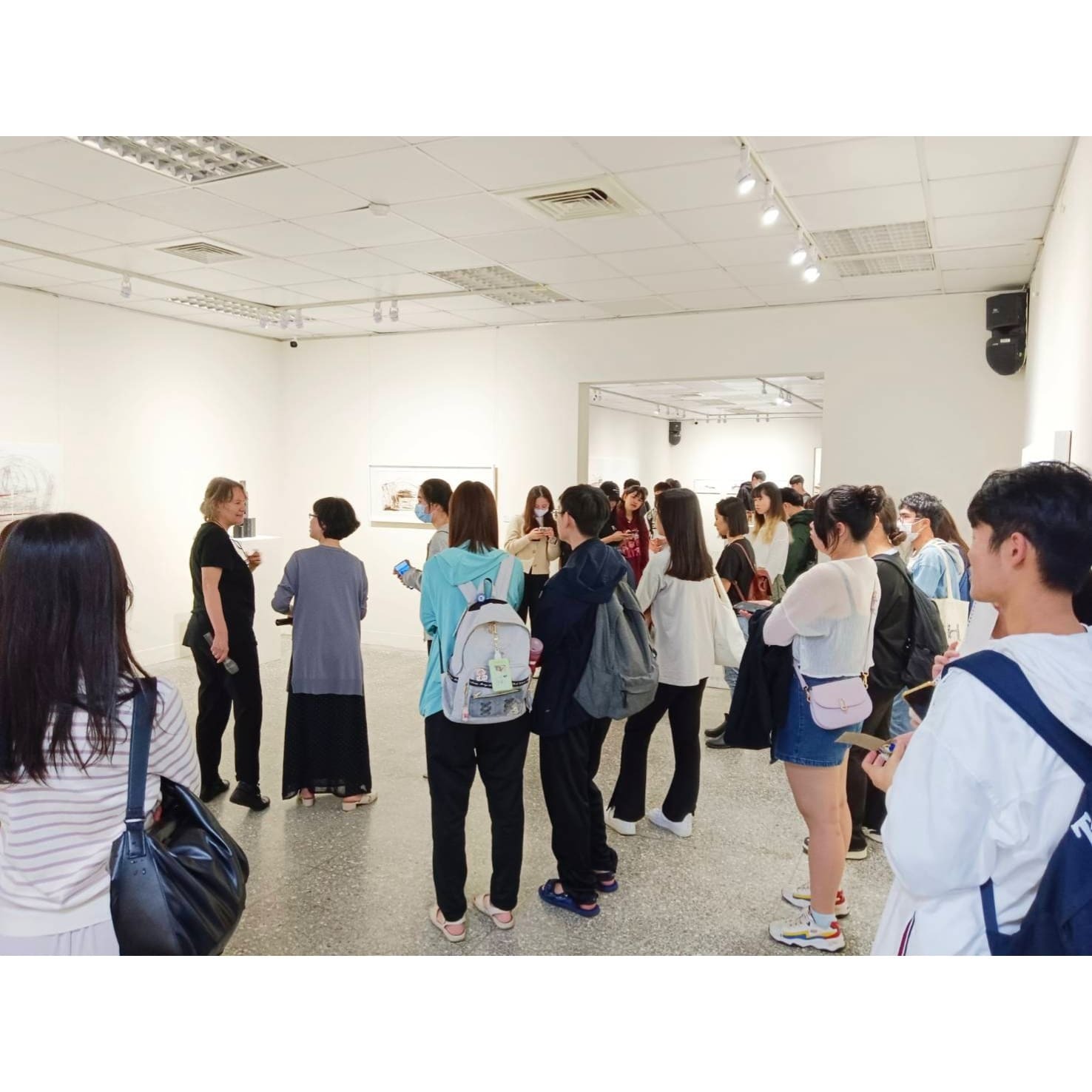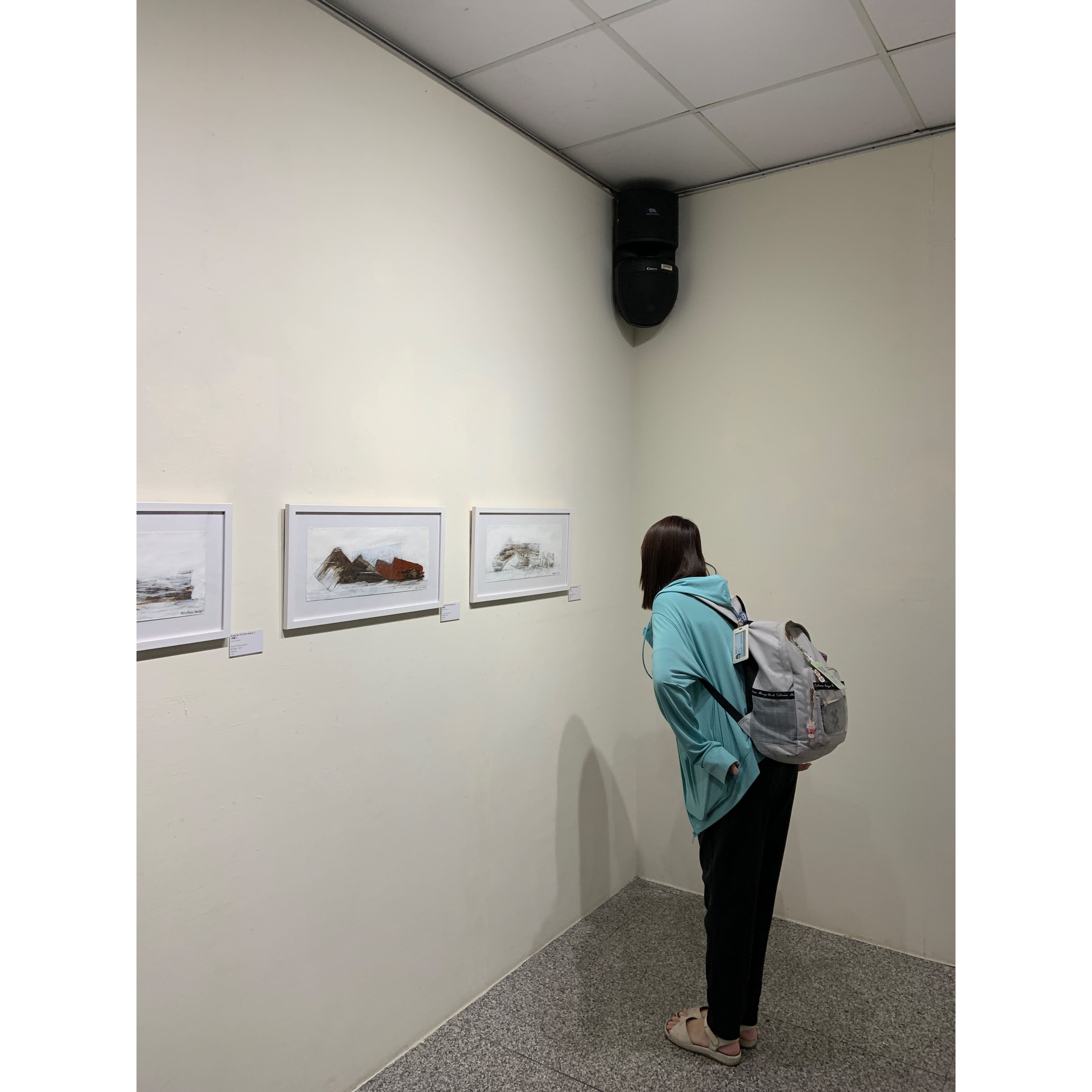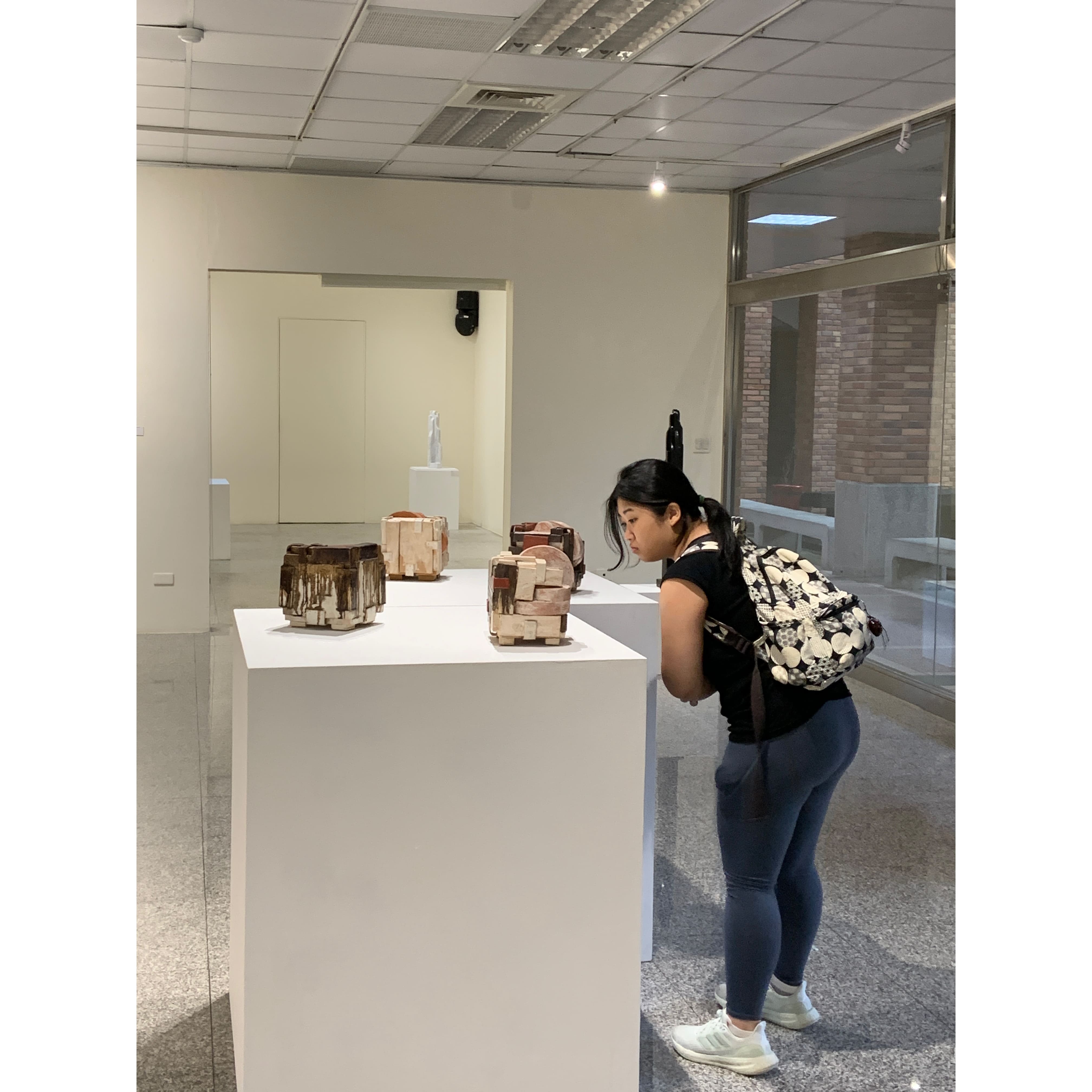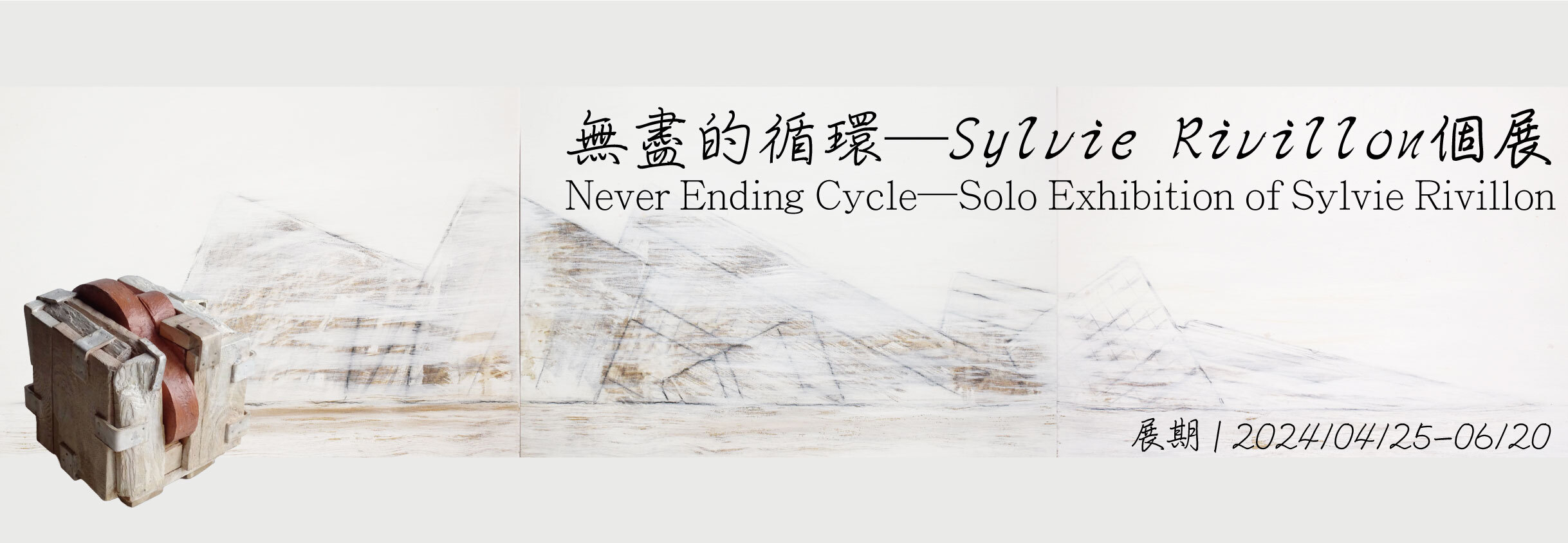

無盡循環的主題變奏曲――記Sylvie Rivillon的靜宜個展
文\彭宇薰 靜宜大學圖書館館長兼藝術中心主任
據說佛祖曾言:「一花一世界,一葉一如來。」這是一種看待世界的方式,諦觀後釋然的心境。
在此,花葉是我與世界接合點的動機,透過觀照的練習,花葉作為某種微觀世界的主題原型,對我展現無限的變奏。
或許法籍藝術家Sylvie Rivillon的藝術作品也可以此角度詮釋之。
Sylvie既從事雕塑創作,也有不少平面作品,二者經常承載類似的理念,旨趣或可互通有無。她的主題原型基本上圍繞在具象性的盒子、橋、波浪,
與概念性的核心、建構、時間、老化等。其中盒子與核心的概念具緊密聯繫的關係,橋、波浪與建構的概念亦如是,時間則是幾乎貫穿所有作品的觀念。
簡言之,Sylvie的原型動機如一花一葉般很單純,箇中發展出的無限變奏曲就是她的諦觀過程。
無論是平面或是立體作品,象徵內在與保護的「盒子與核心」(Box and Core)系列作品,以頗具觸覺性的立方體,讓盒子、核心的概念通過實存與虛無的空間相互作用來體現。
圓形的旋律線條與嚴謹的幾何形狀相對照,不僅展現了流動與靜止的對話,也呈現了自然界循環與人類結構秩序之間的張力。
從質地上來看,作品中細微的劃痕和粗獷的塗抹彰顯了手作的痕跡和時間的流逝,它們不僅創造了豐富的視覺層次,也喚起了對自然老化過程的聯想,呼應了時間與記憶的主題。
同樣強烈呼應時間性的「岸觀」(On the Shore)系列,呈現了海岸線的抽象化形態,
岩石與海浪彷彿在畫面中相互作用,形成視覺上流動感和穩定性的對比。
構圖中明顯的水平線條帶來了一種寧靜與平衡,而斑駁的紋理和刮痕則喚起了海岸線隨時間侵蝕變化,象徵自然的無常。
無論是哪一個作品系列,Sylvie喜愛採用大地色:赭色、白色、紅色、黑色與棕色。無庸置疑的,暖色系與冷色系的對比,進一步增强了作品的情感張力;
前者在視覺上提供了活力和動感,而後者則帶來沉思和靜穆之感,彷彿是柏拉圖宇宙論四元素中的火與土、熱情與冷靜的象徵。
的確,對宇宙萬物基本元素――風、水、土、火――之間交互作用的藝術探索,同樣展現在Sylvie單色系的雕塑作品中。
在與波浪有關的系列作品中,黑色大理石的使用強化了雕塑的細緻與優雅,其光滑與粗糙面的對比則提供了深度和細節,反映了光影的變化,水、風、土本質的暗示不言而喻。
Sylvie的平面作品與雕塑之間的關係,正如她所說:
我的素描或繪畫就像我的雕塑一樣,由連續的層次建構而成,即壓克力、水性與油性繪畫等不同層次。
……我在尋找結構和內部律動之間的平衡。
所有這些畫作並不是我的雕塑草圖;它們是反思的基礎,激發進一步發展的想法。
我喜歡自由流暢的手勢;在「緊急」情況下的工作;這展現了繪畫的迅速性。
然而,這也可能是一個更痛苦的過程,因為它不再提供更冗長的製作雕塑的時間,即允許「消化」結果的時間。
我回到雕塑,有時滿足於與較硬的材料的乏味對抗,那更是一種慰藉。
這段敘述有種令人感動的質地:原來,生命能量順流於迅疾的自由中固然令人愉快,置身於繁瑣冗長的與物之對抗性,或許更能激起存在本身的豐厚力度。
這無關Sylvie藝術的表現成果,但闡述的是藝術家透過實實在在的整個身體感,加以體現世界能量動靜之間平衡的意圖。
爰此,在無盡的主題與變奏的循環中,Sylvie的藝術為我們敞開一個令人期待的諦觀世界。靜宜大學得此機緣展出其作品,誠為師生之幸。謹以為序。
創作自述
That for which there is no word.
Since my childhood, I have been feeling a deep need to express myself through shapes and colours. This has helped me overcome difficult times, consolidate myself and transform my doubts and sorrows into something that can be called pleasure and gives me the desire to move forward. Initially, it was a purely personal exercise, but eventually, after I studied applied arts and attended the School of Decorative Arts in Paris, I realised my personal language could also arise interest and understanding among others; that it could touch beyond words, languages, borders and could be shared.
To tell the truth, I do not feel the need to express my ideas in words; shapes and colours suffice. What I would like to do is not to put an image on words but to sculpt or paint the unspeakable. Whatever I write about my work is therefore more like an attempt to explain it a posteriori.
Although my creations appear to be abstract, they are based on sentimental notions that often relate to the human; I seek such a relationship between Abstraction and Feeling. As far as I am concerned, Abstraction remains the best way to express what I feel. At some point, I did attempt to resort to figuration to achieve the same result, yet it turned out that the paintings and sculptures of faces I produced left me with a sense of vacuity, reflecting only a facade, a barrier. Those few months of trials and errors helped me realise I was looking for something buried deeper in my soul, something I am still looking for today.
The materials I use are various in nature: terracotta, wood, stone, bronze, cement, paper, paint.
I work in series of variations on a given theme or feeling, until I sense my work is running out of breath, as I begin to repeat myself and my desire peters out. That is when I change materials or choose another mode of expression. While such successive changes in materials may appear to give slightly drastic results, in fact, the meaning remains the same, the way the form is constructed keeps following the same progression. Based on that same logic, my paintings or drawings are as important to me as my sculptures; they participate in the evolution of my work, one element helping the other to keep progressing.
My drawings or paintings are built like my sculptures, by successive layers. Layers of acrylic, water, oil paint. The colours are the same as for the sculptures, earth colours: ochre, white, red, black and brown. I draw with pencil the outer structure, the boards. I am looking for the balance between construction and internal movement.
All such drawings are not sketches for my sculptures; they serve as a basis for reflection and trigger ideas to keep progressing further. I like the free flow of gesture; the work under situations of "emergency"; the swiftness of drawing. However, this can also be a more distressing process in the sense that it no longer affords the time inherent to the more tedious execution of a sculpture, a time that allows for a "digestion" of the result. Returning to sculpture and to the satisfaction of what can be at times a tedious confrontation with harder materials is all the more soothing.
Within virtually all of my sculptures - "Human-boxes", "Black Boxes", "Boxes and Cores", "Apparences", "Flow and flow", "Construction around a wave", etc. - in fact in virtually all of my sculptures, a core can be found, sometimes hidden, sometimes partly apparent. It is concealed and protected by a construction built around it.
If in stone, the construction around the core is built from bottom to top, like a wall. Smooth or rough stones, they contain wavy shapes, repetitive waves of ebb and flow giving a feeling of movement in opposition to the fixity of the architectural structure that surrounds them.
If in wood, the assembly around the core seems to be made hurriedly, as a protective box, an armour, a barricade to protect and preserve the fragile terracotta core. The boxes are then painted with successive layers of colours that gradually unite the different materials to recreate a solid and homogeneous shape. Colour transitions attenuate the particularity of each material and make it "one", both skin and soul, recreating a new entity.
TIME... With concrete or cast aluminum sculptures - "Rolled by the sea" - I wanted to "age" these pieces, give the illusion of a body gradually transformed, rolled and mistreated by time. A union or osmosis has been created between the core and its envelope. The surfaces are eroded, sediments have been deposited there. The tossed sculptures are naturally stopped in their movements, after being rolled; they are as if stranded. Perhaps at rest?
In my research, the notion of inner or core space is important; no less important is the notion of time, present, past and future. What I am striving to do is freeze moments in time, suspend them, capture them and share them.
Short suspended moments, the crossing of a look, a thought, sculpting that for which there is no word.
On 12/12/2023
SR.
Translated by Jacques CARRIO
藝術家簡歷
Sylvie Rivillon 絲勒維・希維雍
Sylvie Rivillon早期的雕塑主要以土塑及木頭為媒材,近年則以大理石及花崗石為主,作品多以對比的意象呈現,像是直線與曲線、剛硬與柔軟、粗糙與精緻等。
Rivillon的幾何造型中呈現水面的落潮波動、無垠的地平線、垂直有如延伸向天空的意象,以及在石材色彩上表現象徵陰陽的黑與白,所述說的是人類與宇宙萬物息息相關的相互循環。如同古代中國人認為萬物並非獨立存在,每件事物都是整體的一部分,每一個體相互依存,依附整體宇宙運轉而循環著。
觀看Rivillon的作品似乎能達到心靈的平靜,雖是冰冷的石雕,但其柔和雅緻的線條同時予人一種平衡與寧靜,以及存在的律動感與無限的生命力。
除了雕塑,Rivillon也從事大量繪畫創作,她的繪畫與雕塑是兩條獨立的平行線,互不隸屬,但兩者之間仍具相似的氣質與韻味。部份大幅作品有如潑墨般,磅礡大氣中不失含蓄優雅,比起石雕作品更具張力。
Rivillon曾在法國、西班牙、德國、日本、台灣、韓國等地展出,其公共藝術作品也安置在法國、西班牙、台灣等多處場所。
簡歷
1959 出生於法國
1978 畢業於巴黎國立高等美術學院(ENSBA)
1983 畢業於高等國立高等裝飾藝術學院(ENSAD)
展歷
2019 「現世與永恆」/荷軒新藝空間/聯展/高雄/台灣
2018 21 Gallery Toulouse/個展/土魯斯/法國
2017 La Maison du Roy/個展/席讓/法國
2017 Art Formosa福爾摩沙國際藝術博覽會
2015 「雕塑雙人展―阿希耶勒.莫斯考維奇&絲勒維.希維
雍」/小畫廊/雙個展/高雄/台灣
2015 「方寸之間.想像之外―國際袖珍雕塑展」/赤粒藝術/聯
展/台北/台灣2014 Art aujourd’hui 畫廊/聯展/巴黎/法國
2013 「Ariel Moscovici & Sylvie Rivillon 雕塑展」/赤粒藝術/雙
個展/台北/台灣
2012 「Ariel Moscovici│Sylvie Rivillon 法國雕塑繪畫展」/小畫
廊/雙個展/高雄/台灣
2010 La Maison du Chevalier/個展/卡卡頌/法國
2009 Sala XIII畫廊/個展/西班牙/馬德里
2007 Maria Villalba畫廊/個展/巴塞隆納/西班牙
2005 花蓮國際石雕藝術季/聯展/花蓮/台灣
在地創作工作坊
2005 花蓮國際石雕藝術季/聯展/花蓮/台灣
公共藝術與紀念碑
2012 「潮起潮落」/卡卡頌藝術學院/法國
2011 「長城」/大龍峒公營住宅,台北/台灣
2009 「4個路徑」/圖德拉德杜埃羅/西班牙
2005 「高度」/家安璞石建案/高雄/台灣
2005 「環繞波浪的結構」/花蓮 長虹橋遊憩區/花蓮/台灣
展出作品
























茶會照片
